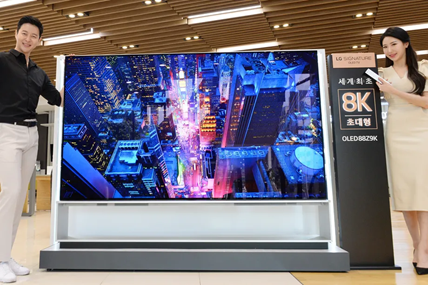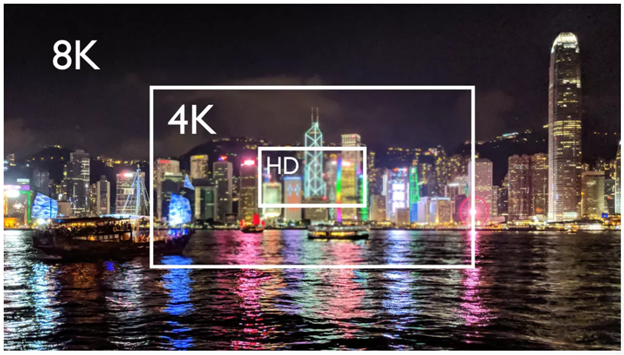High-resolution TV Display Evolution: From HD to 8K and Beyond
The terminology, acronyms, and numerals used to describe today’s television displays can be baffling to an average consumer. First there are the display technologies: LCD, LED, plasma, OLED, QLED (QDEF), and more. And then there is screen resolution: HDTV, HDR, 4K, 8K, 1420 x 1080, 4406, Full HD, Ultra HD (UHD)…the list goes on as consumer electronics manufacturers compete to provide ever-higher image resolution and visual realism. What do these labels mean for display quality, performance, and real-life viewing experiences? And how can manufacturers ensure they deliver on customer expectations for high-end TV displays?
The Resolution Race
The drive to increase screen resolution can be attributed in part to the mainstreaming of digital television images starting in the 1990s. By June 2009, the U.S. Government mandated that broadcasters switch to entirely digital signals. This shift has put pixels—the tiny, illuminated elements of digital displays—at the heart of every television screen.
A typical pixel is made up of three subpixels, one each of red, blue, and green, that are controlled with a thin-film transistor (TFT) and deposited on a thin backplane of glass or other substrate. Inevitably, developers have found ways to increase the number of pixels, make them smaller yet more powerful, and increase their density (pixels/dots per inch, ppi or dpi)—sometimes accomplishing all at the same time.
Television display pixels viewed under a microscope, each with a red, green, and blue subpixel.
Evolving TV Technology & Terminology
To start with, some definitions: HDTV is, of course, “high-definition television”, which became commonplace in the mid aughts, replacing SDTV (standard-definition TV), an earlier digital format. The main difference is the number of pixels. SDTVs typically have 480 rows of pixels and 640 pixels in each row (480 x 640). HDTV, by comparison, typically has 720 or 1080 rows of pixels, providing up to twice the resolution of an SDTV screen.
Including more pixels essentially means higher resolution, corresponding to a more detailed, crisp image on screen. “Today, most HDTVs are described as Full HD (FHD): they use 1080 rows of pixels and 1920 columns, making roughly 2 million pixels (2 megapixels) altogether.”1 In short-hand these are often just called “1080p” displays.
Not to confuse matters, but the “HD” in “HDR” doesn’t stand for high definition; it stands for “high dynamic range.” Dynamic range is a screen’s capability to display sharp contrast, light level gradations from deep black to bright white, and a wider range of vivid colors. High-resolution televisions often provide a better dynamic range, just as they typically provide higher frame rates and other enhanced specifications as manufacturers strive to deliver the best performance across multiple device parameters.
In the early 2010s, television sets emerged that offered 3840x2160 pixels, called “4K”. Yes, 3,840 isn’t quite 4,000, and technically “4K” started out referring to 4,096 x 2,160—the format used for movie theaters. But those dimensions had to be resized to a 16:9 ratio, so the 4K terminology is also applied to 3840x2160 television displays. In fact, most televisions larger than 50-inches sold today are this type of “4K”.2
To make matters more confusing, the term Ultra HD (UHD) was originally coined to for 3849x2160 display screens (to distinguish them from “true” 4096 that applies to 4K cameras). But now it’s common to hear UHD used for any extremely high-resolution TVs, such as “4K UHD”. New 8K screens are also being labeled as UHD. And 4K is also the specification for projectors and professional cameras that do have 4096x2160 pixels, typically known as 4Kx2K.3 This is just a brief overview; sorting out the fine points of pixel counts and screen resolutions could be a whole separate blog post.
| Resolution | Measurement (in Pixels) | Pixel Count |
|---|---|---|
| 8K (Ultra HD) | 7,680 x 4,320 | 33,177,600 |
| 4K (Ultra HD) | 3,840 x 2,160 | 8,294,400 |
|
1080p (Full HD) aka 2K |
1,920 x 1,080 | 2,073,600 |
| 720p (HD) | 1,280 x 720 | 921,600 |
| 480p (SD) | 640 x 480 | 307,000 |
Different screen resolutions and pixels. While a 4K television is roughly twice the dimensions (measurement), it has four times the number of pixels, thus can display comparatively higher-resolution images. (Source: Synopi)
The Dawn of 8K
The big excitement in the market today is about “8K” displays, which boast 7,680 by 4,320 pixels. The first commercial 8K television was released by Sharp in 20154 and the first OLED 8K TV was LG display’s 88-inch screen, released in 2019. While 8K can be seen as simply the next stage in the SD→HD→4K→8K trend, it promises to offer significant performance enhancements. It includes elements of HDR and creates a “looking through the window” image quality, almost like 3D—plus, capturing content in 8K format can enhance image quality even on 2K and 4K televisions.5
Capturing content in 8K format also enables a wider field of view, for example, filming the action across an entire sports field. The 2022 Tokyo Olympics (rescheduled from 2020) will be captured and broadcast in 8K for more of a “you are there” viewing experience on 8K screens.

LG Display’s 88Z9 has an 88-inch OLED panel with 8K Ultra HD resolution (7680 x 4320) — four times more pixels than 4K. The OLED panel itself is the largest that LG has ever shipped in a TV. (Image: LG)
What Do Viewers See?
Human vision is highly acute, but it’s not unlimited. Under normal contrast and within minimum focus distance, our eyes can perceive between 250 and 290 dots per inch. Recent research has determined our eye can distinguish approximately 576 megapixels.6 However, our vision is not uniform, with areas of increased focus at the center (fovea) and less focus on the periphery. Distance also makes a difference: as a viewer is located farther away from a screen, individual pixels blur together more and more: “spatial resolution decreases dramatically increasing the viewing distance (after 1 meter it’s just under 75 DPI) and even falls in situations of low contrast.”7
What does this mean for viewing high-resolution displays? For example, up close, the difference between, say, regular HD and 4K is discernable. However, beyond a distance of approximately one meter from the screen, a typical person cannot tell much difference in image clarity. Sitting on a sofa across the room, both screens might appear to have nearly identical resolution. Where 8K makes a difference for image quality is for extra-large screens greater than 85 inches.
Some analysts argue that 8K doesn’t make a significant difference to the average viewer;8 many other experts foresee that consumers seeking a more immersive and vivid experience will respond to the technology. Although, there is also little 8K content available for viewing—yet. But if history is any guide, the pace of technology change will continue, consumer expectations will continue to rise, and in time 8K will become commonplace. Or eventually it might even feel obsolete as future generations of technology and new breakthroughs usher in viewing experiences we can hardly imagine today.

Comparison of image content displayed at different panel resolutions. (Image: Geoffrey Morrison/CNET)
Quality Considerations
Whether they’ve purchased a television billed as 4K, 8K, UHD or anything else, consumers expect a near-flawless appearance and performance from these high-end, high-priced screens. To ensure quality, manufacturers must rigorously inspect displays at multiple stages in the production process. As screen resolution and pixel density increases, (and pixels shrink to microLED sizes of just a few micrometers wide), advanced, high-resolution inspection systems are required.
Proven Imaging Performance, Higher Resolution
As displays evolve to offer higher and higher resolution, image-based display measurement systems must also increase in resolution and precision. Radiant has long provided some of the premier high-resolution, low-noise imaging photometers and colorimeters in the industry, with software and accessories designed to optimize system performance. Stay tuned for the upcoming Society for Information Display (SID) Display Week 2021 for announcements and previews of our latest generation of display inspection solutions, designed to keep pace with the display resolution evolution.
CITATIONS
- Woodford, C., “HDTV (High-definition television).” ExplainThatStuff!, last updated January 28, 2021. (Retrieved April 28, 2021).
- Morrison, G., “4K vs 8K vs 1080p: TV Resolutions Explained.” CNET, April 22, 2021.
- Pendlebury, T., “What is 4K UHD? Next-generation resolution explained.” CNET, January 29, 2014.
- “The Evolution of Resolution” on Corning.com, The Glass Age / Science of Glass. (Retrieved April 28, 2021)
- Chinnock, C., “The Status of 8K & Light Field/Holographic Development”, SID-LA One-Day Conference 2021, March 25, 2021
- Hamer, Ashley, “How Many Megapixels Is the Human Eye?” Discovery.com, April 1, 2019.
- “TV and Monitors HD 4K: Resolution / Resolution of the Human Eye.” on Stari.co. (Retrieved April 29, 2021).
- Wilkinson, S., “8K vs. 4K TVs: Double blind study by Warner Bros. et al. reveals most consumers can’t tell the difference.” TechHive, February 28, 2020.
Join Mailing List
Stay up to date on our latest products, blog content, and events.
Join our Mailing List
